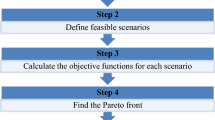Abstract
Indian traffic differs significantly from that of developed countries in many aspects, mainly due to its highly mixed nature and weak lane discipline. Capacity of an uncontrolled intersection plays an important role in the overall performance of urban road networks. The non-compliance of the road users to the traffic rules at uncontrolled intersections makes the situation complex. Moreover, roadside frictions like pedestrians interfere with the traffic flow in most of the intersections in India. Gap acceptance method for capacity estimation has few drawbacks in the practical application under the condition of non-compliance behaviour of drivers including influence of pedestrian cross flow. Capacity estimation of intersection with significant pedestrian cross flow can be possible using the conflict method. This paper aims to study the capacity reduction in uncontrolled intersection having significant pedestrian cross flow. For this purpose, traffic video data were collected from two uncontrolled intersections in Kochi City, onewais an ideal site without significant pedestrian cross flow and the other a pedestrian site with significant pedestrian cross flow. The capacity of ideal and pedestrian intersections was estimated using the Highway Capacity Manual (HCM) method as well as conflict method and a comparison was made between them. HCM method gave lesser values of capacity compared to conflict method and also gave unreasonably higher reduction in capacity due to pedestrian cross flow. This proves that HCM methodology is not suitable when the pedestrian traffic is also considered in addition to vehicular traffic in mixed traffic conditions. It was found that the capacity of the pedestrian intersection is 24.8% lesser than the ideal intersection. This study will be helpful for the traffic engineers to suggest a suitable pedestrian facility to reduce the conflicts between vehicles and pedestrians at intersections.




Similar content being viewed by others
References
Amin HJ, Desai RN, Patel PS (2014) Modelling the crossing behavior of pedestrian at uncontrolled intersection in case of mixed traffic using adaptive neuro fuzzy inference system. J Traffic Logisti Eng 2(4):263–270
Li H, Deng W, Tian Z, Hu P (2009) Capacities of unsignalized intersections under mixed vehicular and non-motorized traffic conditions, transportation research record. Transportation Research Board of the National Academies Washington, D.C. 2130:129–137
Brilon W, Wu W (2001) Capacity at unsignalized intersections derived by conflict technique, transportation research record. Transportation Research Board of the National Academies, Washington, D.C 1776:82–90
Gleue, A. W., VereinfachtesverfahrenzurBerechnungsignalgeregelterKnotenpunkte. ForschungStrassenbau und Strassenverkehrstechnik 136, Bonn, 1972.
Brilon W, Miltner T (2005) Capacity and delays at intersections without traffic signals, transportation research record. Transportation Research Board of the National Academies Washington, D.C 192:32–40
Prasetijo J, Pour MH, Ghadiri SMR (2011) Capacity of unsignalized intersections under mixed traffic conditions. Procedia Soc Behav Sci 16:676–685
Parameswaran A, Asaithambi G. Capacity estimation of uncontrolled intersections in mixed traffic: comparison of gap acceptance procedure and additive conflict flow technique, in proceedings of the 12th transportation planning and implementation methodologies for developing countries, December 2016. pp 19–21.
Highway Capacity Manual, Transportation Research Board (2000). National Research Council, Washington D.C.
Prasetijo J, Wu N, Ambak K, Sanik MS, Daniel BD, Hadipramana J (2016) Performance of non-priority intersections under mixed traffic conditions based on conflict streams analysis. Transportation in Developing Economies 2(2):1–9
Yang Z, Zhang Y, Zhu R, Yei X, Jiang X (2014) Impacts of pedestrians on capacity and delay of major street through traffic at two-way-stop-controlled intersections, Mathematical Problems in Engineering
Mohan M, Chandra S (2016) Three methods of PCU estimation at unsignalized intersections. Transportation Lettes 10(2):68–74
Acknowledgements
The authors acknowledge the opportunity provided by the 4th Conference of the Transportation Research Group of India (4th CTRG) held at IIT Bombay, Mumbai, India between 17th December,2017 and 20th December, 2017 to present the work that forms the basis of this manuscript.
Author information
Authors and Affiliations
Corresponding author
Additional information
Publisher's Note
Springer Nature remains neutral with regard to jurisdictional claims in published maps and institutional affiliations.
Rights and permissions
About this article
Cite this article
T, A., Asaithambi, G. Capacity Analysis of Uncontrolled Intersections with and Without Pedestrian Cross Flow in Mixed Traffic Conditions. Transp. in Dev. Econ. 8, 20 (2022). https://doi.org/10.1007/s40890-022-00159-2
Received:
Accepted:
Published:
DOI: https://doi.org/10.1007/s40890-022-00159-2




